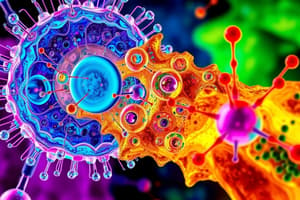Podcast
Questions and Answers
What is the primary use of an ultra microtome?
What is the primary use of an ultra microtome?
- Sterilizing laboratory equipment
- Cutting ultrathin sections for transmission electron microscopy (correct)
- Magnifying small objects for better visibility
- Analyzing the chemical composition of tissues
Which factor facilitates section cutting when using an ultra microtome?
Which factor facilitates section cutting when using an ultra microtome?
- Using a higher frequency blade
- Increasing the temperature
- Applying pressure to the sections
- Lowering the temperature (correct)
A higher rake angle in an ultra microtome helps in:
A higher rake angle in an ultra microtome helps in:
- Increasing the temperature
- Smooth flow of ribbons (correct)
- Slower cutting of soft tissues
- Cutting hard tissues
Which of the following is NOT a part of the ultra microtome as described?
Which of the following is NOT a part of the ultra microtome as described?
How does the consistency of the tissue affect sectioning in an ultra microtome?
How does the consistency of the tissue affect sectioning in an ultra microtome?
Flashcards are hidden until you start studying
Study Notes
Ultra Microtome
- Used to cut ultrathin sections for transmission electron microscopy
- Cuts sections between 40 and 100 nanometric thickness
- Uses glass or diamond knife for cutting
Factors Involved in Cutting
- Lowering the temperature facilitates section cutting
- Higher rake angle helps in smooth flow of ribbons
- Lower rake angle is used for hard tissue
- Soft tissue is cut at a slower rate than hard tissue
Parts of Microtome
- Wheel Lock (A)
- Knife Stage (B)
- Knife Angle Locking Lever (C)
- Knife Locking Lever (D)
Studying That Suits You
Use AI to generate personalized quizzes and flashcards to suit your learning preferences.




